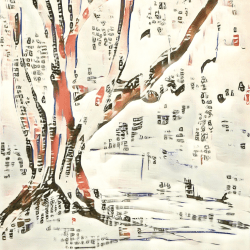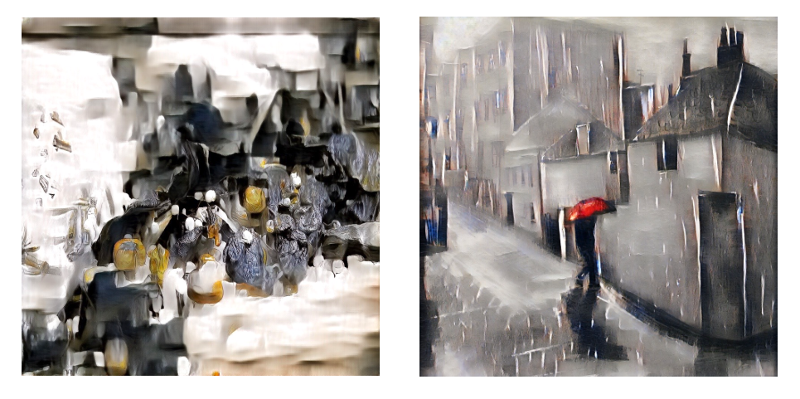Ever since Google’s Deep Dream results were made public several years ago, there has been major interest in the application of AI and neural network technologies to artistic endeavors. [Helena Sarin] has been experimenting in just this field, exploring the possibilities of collaborating with the ghost in the machine.

The work is centered around the use of Generative Adversarial Networks, or GANs. [Helena] describes using a GAN to create artworks as a sort of game. An apprentice attempts to create new works in the style of their established master, while a critic attempts to determine whether the artworks are created by the master or the apprentice. As the apprentice improves, the critic must become more discerning; as the critic becomes more discerning, the apprentice must improve further. It is through this mechanism that the model improves itself.
[Helena] has spent time experimenting with CycleGAN in the artistic realm after first using it in a work project, and has primarily trained it on her own original artworks to create new pieces with wild and exciting results. She shares several tips on how best to work with the technology, around the necessary computing and storage requirements, as well as ways to step out of the box to create more diverse outputs.
Neural networks are hot lately, with plenty of research going on in the field. There’s plenty of fun projects, too – like this cartoonifying camera we featured recently.
















Nope, it isn’t “art”, it isn’t even good design or decoration. It is photoshop filter abuse taken to the next level. Some select pieces that have specific conceptual purposes may be considered art, but all of the rest, a veritable landslide, is vacuous visual pollution. Not even eye candy, more like eye crud. :-( The same thing happened with HDR photos, remember all of those images that looked like garbage as the setting were not used with sophistication, yet the people doing it were so caught up in the novelty of it that they were blind to the fact that they were producing rubbish?
If I may go on a good old fashioned internet rant: Labelling this emerging practice as “not art” feels strikingly similar to the reaction John Philip Sousa and others had to the dawn of recorded & broadcasted music:
“The host of mechanical reproducing machines, in their mad desire to supply music for all occasions, are offering to supplant the illustrator in the class room, the dance orchestra, the home and public singers and players, and so on. Evidently they believe no field too large for their incursions, no claim too extravagant. But the further they can justify those claims, the more noxious the whole system becomes.”
(more here: http://explorepahistory.com/odocument.php?docId=1-4-1A1 )
Today, over 100 years later and with the advantage of hindsight, it’s clear to you and I that Sousa’s reaction was unreasonable: We did not see recorded music *kill* the practice of playing an instrument, or of taking pleasure in music as a social fixture, instead we saw those things revitalized through new ways and spaces for people to create and listen to music. We got people listening to music they would never have had the means to hear at all before, and likewise saw musicians able to gain success in ways that hadn’t been possible. We heard Muddy Waters, Howlin’ Wolf, and other Chicago blues musicians experiment with “broken” amplifiers and pickups to find new sounds, and later Stockausen’s and Hendrix’s use of audio distortion and feedback itself as an instrument. Synthesizers and turntables and drum machines never ruined rock and roll, they gave birth to innumerable new genres and musical communities.
In fact, there’s a discipline of visual art with a storied history that this new development fits into quite nicely: printmaking is the art of automating the creation of a visual image through a repeatable process. An artist creates an original, burns a silkscreen, etches a plate, etc. once, and then produces a series of prints. This process, of course, inevitably introduces variation and play, meaning that the artistic thought and intention that goes into producing a print goes into not just the original or the finished pieces, but the composition of the entire automated process and its inputs.
Machine learning as applied to visual art feels to me like an extension of that practice of printmaking. There is a sense of a back and forth between a human and a programmed, set process which the artist is articulating. Importantly, that’s not a purely one-way relation. An artist’s tools affect the artist and the work enormously; if I try to depict the same thing in a pen drawing and in a woodblock, they’re going to look wildly different. With a tool as complex as a neural net or some other generative model in play, this relation only gains potential for complexity and exploration.
tl;dr No, the sky is not falling, art has not been ruined. Humans just have a new tool to work into how they express themselves. This has happened before.
P.S. regarding HDR — this seems like an odd point of comparison; HDR is still a common photographic technique and is widely used. You likely stopped noticing it because people figured out how to implement it and use it in compositions effectively years ago.
I completely agree with your point, but I feel it’s worth pointing out that depending on what you hold as important in the world the outlook may be bleak as far as human created works are concerned. We are not far from a day when a feedback loop of rewarding imagery generated from engagement leads to snow crash like images targetting everyone separately, with no more human intervention than measuring the response to the images. At this point is it art, or merely visual heroin?
No, you simply fail to understand the difference between art and design or decoration, they all can be good, bad or in between but only one is actually art.
If you failed to get my point about native and gimmicky HDR (or other fx) you need to learn how to do a google search. https://www.google.com/search?q=bad+HDR&oq=bad+HDR
More effort from you put into thinking about my actual point and less effort in spewing reams of superfluous guff would have being appreciated.
Most art is garbage, even when it is actually art, look at how much of his work Picasso felt compelled to destroy. You do know enough about art history to be familiar with that fact?
I’m familiar with the cheesy-HDR effect you’re referring to. I also don’t particularly care whether you appreciated my post or not. As a useful parallel, your definition of “bad art” sounds a whole lot like “art I don’t like” — we can choose to dislike or criticize any artistic work we choose, and yet those works survive our dislike. I think that’s pretty neat! It’s a beautiful thing to be able to create a lasting work or process that can convey part of how you see the world to others.
Also, esign and decoration are both artistic practices.
https://en.wikipedia.org/wiki/Design#Design_and_art
https://en.wikipedia.org/wiki/Decorative_arts
<3
Artistic and “Art” are not the same, a work of fine art can be without any “artistic” characteristics ( in the sense it is used for describing design) and still be art. Also don’t put words into my mouth to ease your task of ignoring my actual point and giving yourself a straw man to argue against, I made a point about the process Picasso used to produce his art. It is not about what I think of his art.
You seem to miss the point completely, what is art, if it is more than just design? You also inadvertently trip yourself up because it is not a person making the art anyway, it is an automata producing data. Where is the artist’s contribution to that, regardless of if in some cases it is of aesthetic value? It isn’t art unless it is from the mind of an artist, at best it is a found object from tensor space. So the person that presents it to the public is just a curator if there is nothing more meaningful attached to the work, no message other than that it exists and here it is to look at.
All human art has one thing in common, it’s production is an affective process that feeds back on itself, and that is why machines can’t produce art even if they can produce designs. Do you understand now?
Thank you for enlightening us. Can you provide true examples of “art”, please ?
https://archive.org/details/whatisart00tols/page/n7
“Ever since Google’s Deep Dream results were made public several years ago, there has been major interest in the application of AI and neural network technologies to artistic endeavors.”
Nice thing about AIs doing art is you’ll never hear them complain about piracy.
But it is humans claiming ownership over the output of those glorified number sieves.